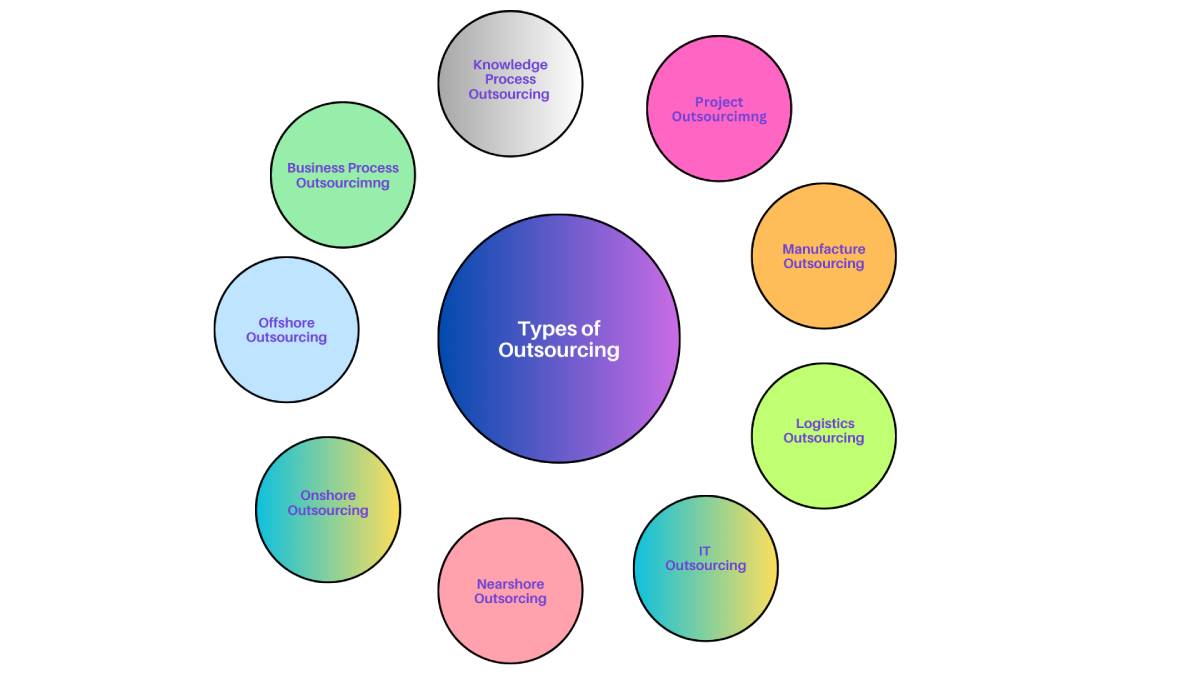What is Outsourcing?
Outsourcing is when a company hires outside vendors to do some tasks instead of doing them inside. Tasks can include customer service, IT support, making things, and moving them around. Outsourcing can cut costs, get special skills or work on main business things, or work better. Lots of companies do it now to use what other groups do well and make their work better.
Reasons for the Demand for Outsourcing
In recent years technology, globalization rules, and market demands have changed very rapidly. In the fast-paced environment, companies are increasingly turning to outsourcing as a strategic tool for survival in the market.
1. Global Pandemic
As we all know, the COVID-19 pandemic has drastically changed the lives of many people and it has also altered the business landscape. Widespread disruptions to supply chain and workforce availability prompted companies to lease their operations and strategies to maintain continuity, manage costs, and leverage external expertise to navigate uncertain times.
2. Digital Transformation
Rapid digital transformation has brought forth both new opportunities and challenges for companies. While these opportunities are enticing, many companies struggle because their existing staff lacks the necessary skills and expertise to face these new challenges. As a result, outsourcing has emerged as a strategic approach to access the specialized skills and capabilities needed for digital initiatives like cloud computing, data analytics, and cybersecurity.
3. Access to the Global Talent Pool
The sudden rise in outsourcing is due to various factors, including the ability to hire talented people from all over the world. Additionally, different countries have different taxes, and outsourcing allows businesses to take advantage of lower tax rates in certain locations. This is also one of the reasons for the sudden increase in outsourcing. Companies can improve their competitiveness and innovation by accessing skilled professionals from different regions and benefiting from favourable tax environments.
4. Scalability and Flexibility
Outsourcing provides both scalability and flexibility these features are important agents behind the demand for outsourcing. This dual advantage allows businesses to swiftly adjust the size and scope of their operations in response to changing market conditions or evolving business needs. During rapid growth or economic uncertainty, outsourcing allows companies to adapt quickly without being locked into long-term commitments.
5. Globalisation
The integration of global markets has
resulted in contributing to the
increased demand for outsourcing.
For example, with India’s economic
liberalization in the early 1990s,
many companies came to India to
establish their company.
In the
same way, many countries are now
open to globalization.
Now
businesses seek to expand their
reach and access new markets, outsourcing
offers a strategic solution.
By leveraging outsourcing, companies
can establish a presence in
different regions, navigate complex
local regulations, and effectively
serve diverse customer bases.
6. Technological Advancements
The fast growth of new tech made companies need to use outsourcing more. Today, new advancements are happening all the time. Companies use outsourcing to get tech skills and knowledge. Things like artificial intelligence, machine learning, cloud services, and blockchain have changed how companies work. To use these new technologies well, companies need new skills. Companies have a hard time with emerging tech. Outsourcing helps them find people with the right skills. This is why companies need to outsource more and more.
Types of outsourcing
There are different types of outsourcing services each for serving specific business needs. Let me explain a few of them.

1. Project outsourcing
Project outsourcing means hiring someone outside of the company to do a specific job or task of a project for a certain period. Instead of doing it themselves or hiring new employees, companies pay another company or individual to get the job done.
Example of project Outsourcing
A company hires an external software development firm to create a custom application or website.
Advantages of project Outsourcing
- Cost Savings: Outsourcing projects are often, cheaper than hiring and training in-house staff to undertake short-term or specialized tasks. Businesses can save on recruitment, training, and overhead costs by outsourcing projects to an external vendor.
- Flexibility: Project outsourcing offers many flexibilities. It allows the companies to scale either up or down their resources according to the project’s needs. Businesses can adjust the scope and duration of the projects easily without any long-term commitments.
- Simply Focus on the Core Competencies: When companies send out projects, they free themselves to focus on the core competencies and strategic objectives. The non-core activities can be effectively taken care of through external vendors, and accordingly, companies are in a better situation to innovate in their core areas.
Disadvantages of project outsourcing
- Efficiency of project: Efficiency is an issue in project outsourcing because maintaining product quality can be challenging when we outsource a project to external manufacturers. It may result in a potential decrease in efficiency and customer dissatisfaction.
- Teams Coordination: Companies may face difficulties while interacting with external project providers because of language barriers or time zone differences, it is harder for in-house teams to work together effectively with the outsourced teams.
- Limited Customization: Outside vendors might have set choices that don’t completely match what the outsourcing company needs. These limited options can decrease flexibility and make it hard to adjust the project to specific needs or changes.
2. Manufacturing Outsourcing
Manufacturing outsourcing means
approaching external manufacturers
to produce goods or components, on
behalf of a company instead of
handling production in-house.
Businesses often use specific
external manufacturers in different
regions, to leverage their expertise
and resources.
By using
manufacturing outsourcing companies
can significantly increase their
production levels.
Example of Manufacturing Outsourcing
Apple company outsourced the production of its iPhones to external agents primarily located in China. These external manufacturers do the work of assembly and production processes. This allows Apple to benefit from the expertise and Apple can focus on product design, marketing, and innovation.
Advantages of Manufacturing Outsourcing
- Manufacturing Expertise: Manufacturing outsourcing allows the company to manufacture their products from anywhere in the world wherever they get the correct expertise and can fulfil their requirements like quality, cost etc.
- Scalability in Production: Manufacturing outsourcing especially allows businesses to scale production up or down on demand. If the demand is high, then the company will outsource more if not outsource less. It decreases unwanted production in the company.
- Focus on Marketing and Innovation: If one outsources manufacturing then they don’t need to worry about manufacturing or following e-commerce trends in the manufacturing industry rather, they can focus on product development, marketing, and innovation.
Disadvantages of manufacturing outsourcing
- Quality Control Issues: Quality control is one of the major issues in manufacturing outsourcing because maintaining product quality can be challenging when outsourced to external manufacturers. It may result in potential quality issues and customer dissatisfaction.
- Communication Challenges: Communication is difficult while dealing with outsourcing manufacturers who are in different time zones, cultural differences can pose a communication challenge between the business and external manufacturers, impacting project coordination and management.
- Supplier Dependency: When the company outsources manufacturing it will be overly dependent on external manufacturing, making it vulnerable to supply chain disruptions, changes in pricing, or fluctuations in quality.
3. Logistics Outsourcing
Logistics outsourcing is hiring external logistics service providers to manage various aspects of the supply chain, such as transportation, warehousing, inventory management, and distribution. This allows businesses to focus on improve efficiency while leveraging the expertise and resources of external logistics partners to meet customer demands effectively.
Example of Logistics Outsourcing
Amazon uses logistics outsourcing from FedEx to handle a significant portion of its package delivery operations. Instead of managing its entire logistics network in-house, Amazon outsources the transportation and delivery of packages to FedEx. This strategic partnership allows Amazon to focus on its core business of retailing while leveraging FedEx’s extensive transportation infrastructure and expertise in package delivery.
Advantages of Logistics Outsourcing
- Transportation Infrastructure: Logistics outsourcing provides access to established transportation networks and infrastructure. It includes trucks and planes. It will benefit organizations by eliminating the need to establish networks.
- Global Reach: A company can get global reach if it uses different logistics outsourcing. If a company wants Indian reach, it can contact an India-based logistics outsourcing agency, or if a company wants America, it can contact an American logistics outsourcing company that will benefit global reach.
- Customer Satisfaction: By outsourcing logistics functions, businesses can focus their time and resources on product development, marketing, and customer service.
Disadvantages of Logistics outsourcing
- Loss of Control: When you outsource logistics, you give up control over how your goods are handled and managed. It can be hard to keep track of everything, leading to a potential loss of control in logistic outsourcing.
- Dependence on Others: Relying heavily on external logistics providers can make your business vulnerable. If they make mistakes or increase prices unexpectedly, it can lead to financial losses for your company.
- Lack of Effective Communication: One may face difficulties when dealing with external logistics providers because of language barriers or time zone differences, making it harder to work together effectively.
4. IT Outsourcing
Outsourcing companies approach external service providers, which deliver IT-enabled business processes, application services, and infrastructure solutions to achieve business objectives effectively. This approach allows businesses to leverage specialized expertise and resources while focusing on essential operations and maximizing efficiency in IT management.
Example of IT Outsourcing
Many companies hire cloud computing services from providers like Amazon Web Services (AWS), Microsoft Azure, or Google Cloud Platform for IT infrastructure and services. These services include cloud storage, computing power, and software development tools, allowing businesses to access scalable and cost-effective IT solutions without investing in their infrastructure.
Advantages of IT Outsourcing
- Access to Advanced Technology: IT outsourcing gives the advantage of cutting-edge technologies and software tools.
- Rapid Innovation and Adaptation: IT outsourcing enables businesses to rapidly adapt to new technologies, innovate processes, and adapt to changing market trends. It will give us time to market our product rather than concentrating on changing market trends.
- Comprehensive IT Solutions: IT outsourcing is a one-stop solution for businesses requiring all kinds of IT services, such as infrastructure management, software development, technical support, and cybersecurity services at a time.
Disadvantages of IT Outsourcing
- Risks in Data Safety: The main disadvantage of IT outsourcing is that one needs to share private information, this sharing of private data with external providers increases the potential chance of unauthorized access and gives huge challenges in safeguarding confidential information.
- Dependency on External Providers: Another main disadvantage of IT outsourcing when one relies heavily on external IT providers can make businesses more vulnerable to disruptions in services, changes in pricing, or fluctuations in quality, compromising operational continuity and performance. This dependence on external providers may be more significant in IT outsourcing arrangements.
- Quality Irregularities: In some cases, external IT providers will only offer standardized solutions that may not match the company’s unique needs and preferences. This will further limit the range of customization options and flexibility and quality irregularities.
5. Nearshore Outsourcing
Nearshore outsourcing is the act of subcontracting business processes or services to companies located near one’s country or to companies located in neighbouring countries. It includes partnering with companies in adjacent countries or regions where it has similar working hours as a company, cultural norms and business processes.
Example of Nearshore Outsourcing
United States based companies may choose to outsource software development or customer support services to a company located in Mexico or Canada, rather than outsourcing to a company located in a distant country like India or the Philippines. Because, nearby countries may offer advantages like easier communication, cultural alignment, and potential cost savings.
Advantages of Nearshore Outsourcing
- Cultural Compatibility: Using nearshore outsourcing from neighbouring countries often creates a greater cultural alignment and understanding between the client and the service provider, resulting in better communication and teamwork.
- Establishing Time Zones: Another key advantage of nearshore outsourcing is that partners generally work at the same time as the client, allowing them to schedule meetings, conference calls and project updates.
- Reduced Legal and Regulatory Risks: Using nearshore outsourcing to countries with similar regulatory frameworks reduces the legal and regulatory risks associated with offshore outsourcing. This includes compliance with labour laws, tax laws and intellectual property protection laws, continuing smooth and efficient operations. Due to this reason, some US-based companies have recently opted for nearshore outsourcing in Latin America.
Disadvantages of Nearshore Outsourcing
- Fewer Cost Savings: This may not provide the same cost savings as offshore outsourcing (countries away) for countries with low labour costs.
- Competition for Resources: Outsourcing locations near the coast may face increased competition for resources, including skilled labour, services and materials, thus increasing costs and potential capacity constraints.
- Limited Reach: Nearshore outsourcing can limit the company’s ability to utilize a broader talent pool or diverse market.
6. Onshore Outsourcing
Onshore Outsourcing
is also
referred to as domestic, companies
engaging in this type of business
process or service delivery model
outsource their operations within
their own country. Unlike offshore
or nearshore outsourcing, which
refers to companies giving
assignments to firms in other
countries but with similar
geographical proximity, on-shore
outsourcing falls within state
borders.
Example of Onshore Outsourcing
A company based in India may choose to outsource its customer service operations to a third-party call centre located in Hyderabad or Mumbai, rather than outsourcing to a call centre overseas.
Advantages of Onshore Outsourcing
- Improved Customer Satisfaction: Domestic outsourcing allows you to work with agents who share your cultural understanding and language, resulting in seamless customer interactions and increased satisfaction.
- Job Creation and Economic Development: By outsourcing domestically, companies can contribute to local job growth and support businesses in their own country, driving economic development
- Legal Compliance: Domestic outsourcing partners follow the same legal framework, reducing the risk of legal issues or compliance violations that may arise when working with international providers.
Disadvantages of Onshore Outsourcing
- Limited Diversity: Relying heavily on local resources can restrict access to a wider range of viewpoints, experiences, and skills, potentially limiting innovation and creative ideas.
- Reduced Scalability: May encounter limitations in scaling operations due to a shortage of qualified labour or resources within the local market, making it difficult to meet high-volume or complex requirements.
- High Cost: In some cases, using onshore outsourcing may have limited scalability, especially in industries or regions with a shortage of skilled labour or resources, making it challenging to get things done with high scalability.
7. Offshore Outsourcing
Offshore outsourcing refers to the process in which companies conduct business operations outside their own countries, usually in regions with very cheap labour and good economic conditions. Additionally benefits, business firms can use specialists from other parts of the world, save some money and at the same time get services they could not otherwise afford.
Example of Offshore Outsourcing
Companies like Apple, Samsung, or Nike utilize offshore outsourcing, where they hire manufacturers of their products from countries like China, Vietnam, or Bangladesh, taking advantage of cheap labour costs and increasing manufacturing productivity.
Advantages of Offshore Outsourcing
- Time Savings: When one uses offshore outsourcing, the outsourcing partners often operate in different time zones, allowing for 24/7 support, faster turnaround times, and extended business hours, enhancing productivity and customer service.
- Access to Skilled Talent: By using Offshore outsourcing provides access to a diverse pool of skilled professionals with specialized expertise and qualifications that may be unavailable in your region.
- Cost Savings: Offshore outsourcing allows businesses to take advantage of lower labour costs in foreign countries, leading to significant cost savings compared to hiring local employees or performing tasks in-house.
Disadvantages of Offshore Outsourcing
- Time Zone Disadvantage: In offshore outsourcing, partners work in different time zones which leads to challenges in communication, coordination and responsiveness. Businesses may experience delays in receiving feedback, or updates due to mismatched working hours. This can result in slower turnaround times, increased response times to customer inquiries, and decreased productivity during overlapping hours, potentially impacting customer service quality and satisfaction.
- Cultural Differences: Offshore outsourcing may involve working with partners from different cultural backgrounds, which could lead to misunderstandings, conflicts, and challenges in aligning values, priorities, and expectations.
8. Business Process Outsourcing (BPO)
In Business Process Outsourcing (BPO), companies subcontract designated business activities such as handling customer inquiries, accounts management, personnel management, and other support services to third-party service providers. BPO enables enterprises to concentrate on what they do best and cuts down business expenditures, as they use other people’s know-how with time being an advantage.
Example of Business Process Outsourcing (BPO)
IBM provides Business Process Outsourcing (BPO) services to American Express, for handling functions related to finance and accounting, human resources, and customer service. American Express leverages BPO outsourcing to optimize its business processes and focus on core competencies while partnering with established service providers like IBM to deliver high-quality services to their customers.
Advantages Of Business Processes Outsourcing
- Focus on Core Activities: The main advantage of outsourcing business processes is that BPO allows companies to utilize their resources on core business activities and strategic initiatives while delegating non-core functions to specialized service providers.
- Access to Advanced Technology and Infrastructure: BPO providers typically invest in advanced technology, software, and infrastructure, allowing companies to access cutting-edge solutions without needing a significant upfront investment.
- Global Reach: BPO providers often operate across multiple countries and regions, allowing companies to access a global talent pool, diverse perspectives, and cultural insights to serve better international markets and customers.
Disadvantages of Business Processes Outsourcing
- Communication Challenges: Outsourcing to offshore locations can lead to communication barriers due to differences in language, accents, and time zones, which may affect collaboration, understanding of requirements, and project management.
- Data Security Risks: Sharing sensitive information, proprietary data, or intellectual property with external providers raises concerns about data security, confidentiality, and the risk of data breaches, theft, or unauthorized access.
9. Knowledge Process Outsourcing (KPO)
Knowledge
Process Outsourcing is
assigning tasks that are intense in
information and need particular
skills in analysis and acquaintance
to third-party companies.
Knowledge services may include
market research data, analytics,
financial analysis, legal services,
scientific research, and other
knowledge-intensive functions.
Example of Knowledge Process Outsourcing (KPO)
Wipro offers KPO services such as research and development, engineering services, intellectual property management, and data analytics to clients in technology, healthcare, energy, and other industries.
Advantages of knowledge Processes Outsourcing:
- Higher Value Addition: Knowledge process outsourcing gives strategic insights, actionable recommendations, and value-added solutions that contribute to business growth, innovation, and competitive advantage, beyond routine operational support.
- Enhanced Decision-Making: Knowledge processes outsourcing It will give better-informed decision-making, improved strategic planning, and more accurate forecasts based on comprehensive data analysis and market intelligence for complex analytical tasks.
Disadvantages of Knowledge Process Outsourcing (KPO)
- Dependency on External Providers: Heavy dependence on KPO providers can create dependencies and vulnerabilities. This can make companies susceptible to disruptions, service failures, or conflicts of interest if the outsourcing relationship deteriorates.
- Reputational
risks:
If the Outsourced workers don’t perform in the knowledge process outsourcing then the reputation of the client organisation. It will lead to a loss of trust and negative publicity. - Loss of Control: In this outsourcing, one needs to outsource important operations and decisions. In some cases, it may create a loss of direct control over critical business functions.
Tips for Better Outsourcing Results
- Define Requirements Clearly: When outsourcing tasks or projects, make sure that your requirements are clear and easy to understand. This clarity helps the outsourced employee grasp your expectations and allows you to assess whether the outsourcing agency can meet those requirements.
- Choose the Right Partner: Choosing the right outsourcing partner is important because they need to meet your requirements, handle market disruptions, have experience in the field, and fit within your budget.
- Make Regular Reviews on Outsourcing Work: Regularly review the outsourcing work. By doing so, you can identify and address any issues early on.
- Set Realistic Expectations: Consider the time limit, the available resources, and the nature of the work. Through this, you avoid disappointment and keep all concerned happy about the results.
- Monitor Performance – using a time-tracking software: Performance monitoring may include time-tracking software like Time Champ. This will result in significant improvement in general performance. It offers advanced features like automatic attendance tracking, employee monitoring, productivity tracking, and project management. This creates a condition of efficient remote work management maximizes outsourcing efficiency and enhances productivity and commitment in remote working conditions.
enhance the performance of your outsourced teams
with the best time tracking software Time Champ
Sign up for FreeBook DemoConclusion
Outsourcing has emerged as a leading
giant in corporate operations within
the dynamic market environment. The
global pandemic, digital
transformation, and globalization
are other major drivers for
outsourcing demand. There are
different varieties of outsourcing,
such as project, manufacturing,
logistics, IT, nearshore, onshore,
offshore, BPO, and KPO, to get
smooth operations, grab the
specialized skills, and cost
reduction.
To get better
outcomes with outsourcing, it is
always advised to have clear idea of
requirements, good partner
selection, periodic review,
realistic expectations, and
performance-tracking tools, such as
time-tracking software. With these
kinds of strategies, businesses will
be able to get optimum efficiency,
innovation, and competitive
advantage in today’s dynamic
business environment.
Frequently asked questions
Outsourcing can be described as a firm employing outside suppliers to do certain jobs for them rather than using their employees. Such activities may vary from customer care and IT support to production and transport.
Organizations may outsource operations for several reasons such as saving costs, gaining specialized knowledge or skills, focusing on core business functions, improving efficiency and remaining competitive.
Accordion Cont
The
increase in demand for
outsourced services can
be attributed to factors
like the COVID-19
pandemic,
digitalization, access
to the global talent
pool, scalability
options available with
third-party providers
(TPPs) and Globalization
trends towards
interconnectivity among
different economies.
Also, technological
advances have played a
significant role here
too.
ent
Different types of outsourcing serve various purposes. For example, Project Outsourcing refers to when companies hire other firms outside their own company to complete certain tasks within a project they are working on. Manufacturing outsourcing, logistics outsourcing and IT outsourcing are examples where companies get external help on production processes or supply chain management from third parties located elsewhere, nearshore outsourcing involves contracting neighbouring countries.
Project outsourcing occurs when a company hires another company to work on specific tasks or the entire project. The outsourcing company and the outsourced company will negotiate terms, plan the project, monitor progress, ensure quality, complete the project, review the work done, and close the contract.
There are various benefits of outsourcing getting the skills needed , saving money, growing easily, concentrating on main tasks, reaching people worldwide , and using better technology tools.
Some of the downsides to outsourcing are quality control issues, communication challenges, dependence on external providers, lack of control, cultural differences, data security risks and limited customization.
Businesses must define clear requirements, the right partners should be selected, regular reviews of outsourcing work need to be done, and realistic expectations ought to be established. As well as performance monitored by using tools such as Time Champ an example being Time Champ to ensure successful outsourcing with this company.
Apple is one company that
outsources iPhone
manufacturing to
companies in China.
Amazon outsources its
package delivery
operations to
FedEx.
IBM offers
business process
outsourcing services to
American Express,
thereby IBM offers
business process
outsourcing services to
American Express.
Providing clear requirements, choosing partner correctly, reviewing constantly, setting realistic expectations and using software tool like Time Champ are some useful tips to improve your outsourced activities.







